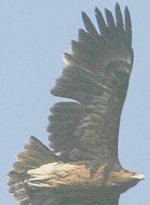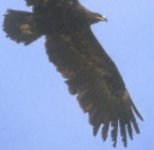ok here's some relevant (I hope) from a brief e-mail discussion with expert Steve Parry re a possible article for an OBC Pub. Hope Steve doesn't mind....
It is certainly the case that there are many misidentifications......
hastata is probably very rare and its conservation status is desperately in need of critical
re-evaluation. They no longer appear to occur in many areas from which 19th century specimens were taken.
Separating juvenile
hastata from
clanga in the field is very easy, juv
clanga are exceptionally distinctive. But adults are another matter, they basically just look brown in the field and that is largely it in terms of plumage!!! The relatively minor plumage differences between the two are absolutely consistent but relatively subtle and are probably difficult to spot in field conditions. Gape/head size, extensive 'lips',overall size and
vocalizations of hastata are probably the best criteria for field observers who have not examined museum specimens or live birds in the hand.
Hastata are smaller than
clanga but their skulls are the same size or actually
larger in sexwise comparisons- so they have a very different jizz. This is very obvious when you know what to look for.
There are probably also habitat differences between the two.
Hastata seems to take mostly small mammals in dry(ish) woodland/savanna habitats whereas wintering
clanga tend to wetter habitats. I think that most of the reports of
hastata from
jheels etc are probably wintering
clanga hunting amphibians.
Available evidence also suggests that
clanga may very rarely breed in India. This is controversial but some specimen evidence seems to support this. Another cause for concern are young
A. rapax vindhiana - some of these have a 'spotted plumage' (quite unlike their African conspecifics) and are superficially similar in this respect to young
hastata. They also have relatively large gapes. However, both
hastata and
clanga have very elongate legs and relatively small feet. They also have small, rounded external nares (nostrils) [as in your photo.]
A. rapax vindhiana have slit-like nares, bigger
deeper bills and short thickish tarsi with relatively larger
feet. They also differ in a number of plumage traits. All three differ in size but female
hastata, male
clanga and male
rapax overlap in several measures of size.
there....that clears that up then






